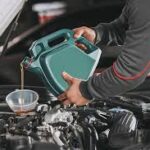
Refueling carelessly might seem harmless, but it can result in unexpected engine issues over time. Factors such as fuel type, contaminants, and even how you handle the gas cap can affect engine health. When fuel isn’t handled correctly, your engine can experience problems like reduced efficiency, misfires, or even long-term damage.
Use the Right Fuel Type
Choosing the Right Octane Level
Modern engines are designed to run on specific fuel types. Using the wrong octane level may lead to engine knocking, which can cause internal damage over time. For example, if your car requires premium fuel, using regular fuel might save money initially but could cost you in repairs later.
Check Your Vehicle’s Manual
If you’re unsure, always consult your vehicle’s manual. It provides detailed information on the correct type of fuel to use and the consequences of using the wrong one.
Avoid Overfilling the Tank
The Risk of Fuel Overflow
While it might be tempting to add “just a little more” after the pump stops, overfilling can lead to fuel overflow. This can damage the vapor collection system, which plays a critical role in reducing harmful emissions.
Avoiding Damage to the EVAP System
Modern vehicles are equipped with an EVAP (Evaporative Emission Control System) that helps prevent fuel vapor from escaping into the atmosphere. Overfilling can overwhelm this system, potentially causing costly repairs down the road.
Keep the Fuel Cap Tightly Sealed
A loose or missing fuel cap can lead to issues in both engine performance and fuel efficiency. When the fuel cap isn’t properly sealed, fuel vapor can escape, which affects the EVAP system and can trigger the “Check Engine” light.
Preventing Fuel Evaporation
Tightening your fuel cap can prevent fuel evaporation, ensuring you get the most out of every tank.
Be Cautious of Fuel Quality
Fuel quality isn’t always guaranteed, especially if you’re refueling at unfamiliar or independent stations. Contaminated or low-quality fuel can introduce impurities into your engine, leading to clogs and decreased performance.
Opt for Trusted Gas Stations
Whenever possible, use gas stations you know and trust, preferably those with high fuel turnover. High-quality stations filter their fuel, ensuring fewer contaminants end up in your engine.
Avoid Running the Tank Too Low
Driving on an empty tank can pull dirt and debris from the bottom of the tank into your engine, which could lead to clogs and other problems. Keeping your tank above a quarter full helps maintain clean fuel flow and reduces the risk of contamination.
Preventing Fuel Pump Overheating
The fuel pump relies on gasoline to keep cool, so a low tank increases the risk of overheating, which can lead to costly repairs or even replacement.
Be Aware of Water Contamination Risks
Water in the fuel tank can spell trouble for your engine. When water mixes with fuel, it reduces combustion efficiency, which can lead to misfires and rough idling.
Check for Fuel Quality Regularly
If you suspect water contamination, have a professional check your fuel system. Some gas stations add ethanol to fuel, which attracts water, so make sure to refuel at reputable places.
Stay Away from Smoking or Using Flames Near Fuel
Refueling stations are full of flammable vapors. Even a small spark can cause a fire, putting you and others at risk. Always avoid smoking or any open flames near fuel, as this is one of the most dangerous aspects of refueling.
Wait for the Tank to Cool Down Before Refueling
If you’ve been driving for a long time, it’s a good idea to wait a few minutes before refueling. The intense heat can make the fuel expand rapidly, leading to potentially hazardous vapor emissions.
Safety Precautions for Hot Engines
Refueling a hot engine can release more vapors, which can be harmful if inhaled and may also increase fire risk.
How Fuel Can Affect Modern Engines
Engines today are complex and finely tuned for optimal performance. Low-quality or wrong-type fuel can interfere with engine sensors, fuel injectors, and the overall combustion process. Always aim to use high-quality fuel, and follow manufacturer recommendations to avoid problems down the line.
Frequently Asked Questions (FAQs)
1. How often should I replace my fuel cap?
Fuel caps don’t have a strict replacement timeline, but it’s recommended to inspect them periodically for cracks or wear.
2. Can I use a higher octane fuel than recommended?
Yes, but it’s generally unnecessary. Using higher octane fuel than your car requires doesn’t improve performance and can be an extra expense.
3. How do I know if fuel quality is an issue?
Signs include rough idling, stalling, and reduced fuel efficiency. If you suspect fuel quality, consult a mechanic.
4. Is it safe to fill up with the engine running?
It’s best to turn off the engine when refueling. Running engines can increase the risk of fire or vapor emissions.
5. Why is it bad to “top off” my tank?
Overfilling your tank can damage the EVAP system and may cause gasoline spills, leading to environmental harm.
Conclusion
Refueling is an essential part of vehicle maintenance, but it’s often overlooked in terms of how it affects engine health. By following the steps outlined here—using the right fuel, avoiding overfilling, securing the gas cap, and more—you can protect your engine from unnecessary wear and damage. Keeping these tips in mind will not only extend the life of your car but also make each refueling safer and more efficient.






